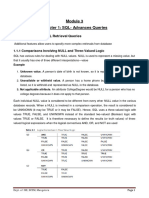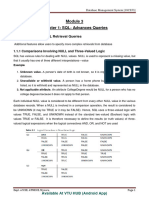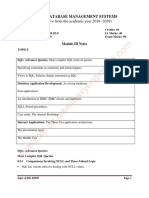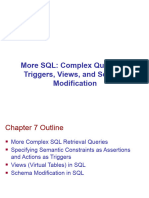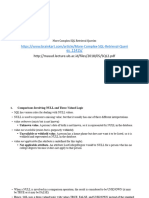0 ratings0% found this document useful (0 votes)
40 views66 pagesDbms Mod3@Azdocuments - in
Uploaded by
308 Nandan BhatkalCopyright
© © All Rights Reserved
We take content rights seriously. If you suspect this is your content, claim it here.
Available Formats
Download as PDF or read online on Scribd
0 ratings0% found this document useful (0 votes)
40 views66 pagesDbms Mod3@Azdocuments - in
Uploaded by
308 Nandan BhatkalCopyright
© © All Rights Reserved
We take content rights seriously. If you suspect this is your content, claim it here.
Available Formats
Download as PDF or read online on Scribd
You are on page 1/ 66
Database Management System [18CS:
Module 3
Chapter 1: SQL- Advances Queries
1.1 More Complex SQL Retrieval Queries
Additional features allow users to specify more complex retrievals from database
4.1.1 Comparisons Involving NULL and Three-Valued Logic
SQL has various rules for dealing with NULL values. NULL is used to represent a missing value, but
that it usually has one of three different interpretations—value
Example
1. Unknown value. A person's date of bith is not known, so it is represented by NULL in the
database.
2. Unavailable or withheld value. A person has a home phone but does not want it to be
listed, so itis withheld and represented as NULL in the database.
3. Not applicable attribute. An attribute CollegeDegree would be NULL for a person who has no
college degrees because it does not apply to that person.
Each individual NULL value is considered to be different from every other NULL value in the various
database records. When a NULL is involved in a comparison operation, the result is considered to
be UNKNOWN (it may be TRUE or it may be FALSE). Hence, SQL uses a three-valued logic with
values TRUE, FALSE, and UNKNOWN instead of the standard two-valued (Boolean) logic with
values TRUE or FALSE. tis therefore necessary to define the results (or truth values) of three-
valued logical expressions when the logical connectives AND, OR, and NOT are used
Table 5_Losicel Conn
vee: Valued Logie
@ AND TRUE FALSE UNKNOWN
“TRE Ss TRUE=—~—~C«~SALSE===S*C«NKNQWNN
FALSE FALSE FALSE FALSE
UNKNOWN UNKNOWN FALSE UNKNOWN
cy on TRUE FALSE UNKNOWN
a rn CTT TRUE TRUE
FALSE, TRUE FALSE, UNKNOWN
UNKNOWN TRUE UNKNOWN UNKNOWN
© not
“TRUE —C«|CALSED
FALSE, TRUE
UNKNOWN UNKNOWN
Dept. of CSE, ATMECE, Mysuru Page 1
Database Management System [18CS:
‘The rows and columns represent the values of the results of comparison conditions, which would
typically appear in the WHERE clause of an SQL query.
In select-project-join queries, the general rule is that only those combinations of tuples that evaluate
the logical expression in the WHERE clause of the query to TRUE are selected. Tuple combinations
that evaluate to FALSE or UNKNOWN are not selected.
SQL allows queries that check whether an attribute value is NULL using the comparison operators
1S or IS NOT.
Example: Retrieve the names of all employees who do not have supervisors.
SELECT Frame, Lname
FROM EMPLOYEE
WHERE Super_ssn IS NULL;
1.1.2 Nested Queries, Tuples, and Set/Multiset Comparisons
Some queries require that existing values in the database be fetched and then used in a
‘comparison condition. Such queries can be conveniently formulated by using nested queries,
which are complete select-from-where blocks within the WHERE clause of another query. That
other query is called the outer query
Examplet: List the project numbers of projects that have an employee with last name ‘Smith’ as
manager
SELECT DISTINCT Poumber FROM PROJECT WHERE
Pnumber IN
(SELECT Prumber FROM PROJECT, DEPARTMENT, EMPLOYEE
WHERE Dnum=Dnumber AND Mgt_ssn=Ssn AND Lname='smith’);
Example2: List the project numbers of projects that have an employee with last name ‘Smith’ as
either manager or as worker.
SELECT DISTINCT Prumber FROM PROJECT WHERE
Pnumber IN
(SELECT Phumber FROM PROJECT, DEPARTMENT, EMPLOYEE
WHERE Dnum=Dnumber AND Mgr_ssn=Ssn AND Lname='smith’)
oR
Prumber IN
(SELECT Pno FROM WORKS_ON, EMPLOYEE WHERE Essn=Ssn AND
Lname='smith’);
We make use of comparison operator IN, which compares a value v with a set (or multiset) of
values V and evaluates to TRUE if vis one of the elements in V.
Dept. of CSE, ATMECE, Mysuru Page 2
Database Management System [18CS:
‘The first nested query selects the project numbers of projects that have an employee with last name
“Smith’ involved as manager. The second nested query selects the project numbers of projects that
have an employee with last name ‘Smith’ involved as worker. In the outer query, we use the OR
logical connective to retrieve a PROJECT tuple if the PNUMBER value of that tuple is in the result
of either nested query.
SQL allows the use of tuples of values in comparisons by placing them within parentheses. For
‘example, the following query will select the Essns of all employees who work the same (project
hours) combination on some project that employee “John Smith’ (whose Ssn = 123456789") works
on
SELECT DISTINCT Essn
FROM WORKS_ON
WHERE (Pro, Hours) IN( SELECT Pro, Hours
FROM WORKS_ON
WHERE — Essn='123456789" js
In this example, the IN operator compares the subtuple of values in parentheses (Pno,Hours) within
‘each tuple in WORKS_ON with the set of type-compatible tuples produced by the nested query.
Nested Queries::Comparison Operators
Other comparison operators can be used to compare a single value v to a set or multiset V. The =
ANY (or = SOME) operator returns TRUE if the value v is equal to some value in the set V and is
hence equivalent to IN. The two keywords ANY and SOME have the same effect. The keyword ALL
‘can also be combined with each of these operators. For example, the comparison condition (v >
ALL V) returns TRUE if the value v is greater than all the values in the set (or multiset) V. For
‘example is the following query, which retums the names of employees whose salary is greater than
the salary of all the employees in department 5
SELECT Lname, Frame
FROM EMPLOYEE
WHERE Salary > ALL ( SELECT Salary
FROM EMPLOYEE
WHERE Dno=5 );
In general, we can have several levels of nested queries. We can once again be faced with possible
ambiguity among attribute names if attributes of the same name exist—one in a relation in the
FROM clause of the outer query, and another in a relation in the FROM clause of the nested query.
The rule is that a reference to an unqualified attribute refers to the relation declared in the
innermost nested query.
To avoid potential errors and ambiguities, create tuple variables (aliases) for all tables referenced in
SQL query
Dept. of CSE, ATMECE, Mysuru Page 3
Database Management System [18CS:
Example: Retrieve the name of each employee who has a dependent with the same first name and
is the same sex as the employee
SELECT E.Fname, E.Lname
FROM EMPLOYEE AS E
WHERE E.Ssn IN ( SELECT Essn
FROM DEPENDENT AS D
WHERE E.Frame=D.Dependent_name
AND E.Sex=D.Sex );
In the above nested query, we must qualify E.Sex because it refers to the Sex attribute of
EMPLOYEE from the outer query, and DEPENDENT also has an attribute called Sex.
1.1.3 Correlated Nested Queries
Whenever a condition in the WHERE clause of a nested query references some attribute of a
relation declared in the outer query, the two queries are said to be correlated,
Example:
SELECT E.Fname, E.Lname
FROM EMPLOYEE AS E
WHERE E.Ssn IN ( SELECT Essn
FROM DEPENDENT AS D
WHERE E.Fname=D.Dependent_name
AND E.Sex=D Sex );
The nested query is evaluated once for each tuple (or combination of tuples) in the outer query. we
‘can think of query in above example as follows: For each EMPLOYEE tuple, evaluate the nested
‘query, which retrieves the Essn values for all DEPENDENT tuples with the same sex and name as
that EMPLOYEE tuple; if the Ssn value of the EMPLOYEE tuple is in the result of the nested query,
then select that EMPLOYEE tuple.
1.1.4 The EXISTS and UNIQUE Functions in SQL
EXISTS Functions
‘The EXISTS function in SQL is used to check whether the result of a correlated nested query is
emply (contains no tuples) or not. The result of EXISTS is @ Boolean value
+ TRUE if the nested query result contains at least one tuple, or
+ FALSE if the nested query result contains no tuples.
For example, the query to retrieve the name of each employee who has a dependent with the same
first name and is the same sex as the employee can be written using EXISTS functions as follows:
SELECT E.Fname, E.Lname
Dept. of CSE, ATMECE, Mysuru Page 4
Database Management System [18CS:
FROM EMPLOYEE AS E
WHERE EXISTS ( SELECT *
FROM DEPENDENT AS D
WHERE E.Ssn=D.Essn AND E.Sex=D.Sex
AND E.Fname=D.Dependent_name);
Example: List the names of managers who have at least one dependent
SELECT Frame, Lname
FROM EMPLOYEE,
WHERE EXISTS ( SELECT *
FROM DEPENDENT
WHERE Ssn=Essn )
AND
EXISTS ( SELECT *
FROM DEPARTMENT
WHERE Ssn=Mgr_ssn );
In general, EXISTS(Q) retums TRUE if there is at least one tuple in the result of the nested query Q,
and it returns FALSE otherwise.
NOT EXISTS Functions
NOT EXISTS(Q) returns TRUE if there are no tuples in the result of nested query Q, and it returns
FALSE otherwise.
Example: Retrieve the names of employees who have no dependents.
SELECT Fname, Lname
FROM EMPLOYEE
WHERE NOT EXISTS ( SELECT *
FROM DEPENDENT
WHERE Ssn=Essn )
For each EMPLOYEE tuple, the correlated nested query selects all DEPENDENT tuples whose
Essn value matches the EMPLOYEE Ssn; if the result is empty, no dependents are related to the
‘employee, so we select that EMPLOYEE tuple and retrieve its Frame and Lname.
Example: Retrieve the name of each employee who works on all the projects controlled
by department number 5
SELECT Frame, Lname
Dept. of CSE, ATMECE, Mysuru Page S
Database Management System [18CS:
FROM EMPLOYEE
WHERE NOT EXISTS ( ( SELECT Phumber
FROM PROJECT
WHERE Dnum=5)
EXCEPT ( SELECT Pno
FROM WORKS_ON
WHERE Ssn=Essn) );
UNIQUE Functions
UNIQUE(Q) retums TRUE if there are no duplicate tuples in the result of query Q; otherwise, it
retums FALSE. This can be used to test whether the result of a nested query is a set or a multiset
1.1.5 Explicit Sets and Renaming of Attributes in SQL
IN SQL it is possible to use an explicit set of values in the WHERE clause, rather than a nested
query. Such a set is enclosed in parentheses.
Example: Retrieve the Social Security numbers of all employees who work on project numbers 1, 2,
or.
SELECT DISTINCT Essn
FROM WORKS_ON
WHERE Pro IN (1, 2, 3);
In SQL, it is possible to rename any attribute that appears in the result of a query by adding the
qualifier AS followed by the desired new name
Example: Retrieve the last name of each employee and his or her supervisor
SELECT E.Lname AS Employee_name,
S.Lname AS Supervisor_name
FROM EMPLOYEE AS E,
EMPLOYEE AS S
Dept. of CSE, ATMECE, Mysuru Page 6
Database Management System [18CS:
1.1.6 Joined Tables in SQL and Outer Joins
‘An SQL join clause combines records from two or more tables in a database. It creates a set that
can be saved as a table or used as is. A JOIN is a means for combining fields from two tables by
Using values common to each. SQL specifies four types of JOIN
1. INNER,
2. OUTER
3. EQUNOIN and
4, NATURAL JOIN
INNER JOIN
‘An inner join is the most common join operation used in applications and can be regarded as the
default join-type. Inner join creates a new result table by combining column values of two tables (A,
‘and B) based upon the join- predicate (the condition). The result of the join can be defined as the
‘outcome of first taking the Cartesian product (or Cross join) of all records in the tables (combining
every record in table A with every record in table B)—then return all records which satisfy the join
predicate
Example: SELECT * FROM employee
INNER JOIN department ON
employee dno = department. dnumber,
EQUIJOIN and NATURAL JOIN
An EQUIJOIN is a specific type of comparator-based join that uses only equality comparisons in the
join-predicate. Using other comparison operators (such as <) disqualifies a join as an equijoin.
NATURAL JOIN is a type of EQUIJOIN where the join predicate arises implicitly by comparing all
‘columns in both tables that have the same column-names in the joined tables. The resulting joined
table contains only one column for each pair of equally named columns
SELECT — Fname, Lname, Address
FROM EMPLOYEE|NATURAL JOIN
DEPARTMENT
WHERE Dname="Research 5
Dept. of CSE, ATMECE, Mysuru Page 7
Database Management System [18CS53]
If the names of the join attributes are not the same in the base relations, itis possible to rename the
attributes so that they match, and then to apply NATURAL JOIN. In this case, the AS construct can
be used to rename a relation and all its attributes in the FROM clause.
CROSS JOIN retums the Cartesian product of rows from tables in the join. In other words, it will
produce rows which combine each row from the first table with each row from the second table.
OUTER JOIN
‘An outer join does not require each record in the two joined tables to have a matching record. The
joined table retains each record-even if no other matching record exists. Outer joins subdivide
further into
+ Left outer joins
+ Right outer joins
+ Full outer joins
No implicit join-notation for outer joins exists in standard SQL.
>» LEFT OUTER JOIN
» Every tuple in left table must appear in result
» If no matching tuple
Padded with NULL values for attributes of right table
QBA: SELECT —ELname AS Employee_name, S.Lname AS Supervisor_name | Sewing: he hae,
FROM EMPLOYEE AS E, EMPLOYEE ASS ak on PLOTEE mp
WHERE — ESupor_ssn=8.Sen: rae ae we eS
1 ewer ogre tall
Q8B: SELECT — E.Lname AS Employee_name, Gtr vont becet
S.Lname AS Supervisor_name _L##*#t
FROM EMPLOYEE AS E|LEFT OUTER JOINJEMPLOYEE AS S
[ONJE.Super_ssn=S.Ssn)3
Dept. of CSE, ATMECE, Mysuru Page 8
Database Management System [18CS53]
>» RIGHT OUTER JOIN
> Every tuple in right table must appear in result
» Ifno matching tuple
Padded with NULL values for the attributes of left table
» FULL OUTER JOIN
» a full outer join combines the effect of applying both left and right outer
joins.
» Where records in the FULL OUTER JOINed tables do not match, the
result set will have NULL values for every column of the table that lacks
a matching row.
» For those records that do match, a single row will be produced in the
result set (containing fields populated from both tables).
Not all SQL implementations have implemented the new
syntax of joined tables.
In some systems, a different syntax was used to specify outer
joins by using the comparison operators +=, =+, and +=+ for
left, right, and full outer join, respectively
For example, this syntax is available in Oracle.To specify the
left outer join in Q8B using this syntax, we could write the
query Q8C as follows:
asc: SELECT E.Lname, S.Lname
FROM EMPLOYEE E, EMPLOYEE S
WHERE E.Super_ssn += S.Ssn;
Dept. of CSE, ATMECE, Mysuru Page 9
Database Management System [18CS:
MULTIWAY JOIN
Itis also possible to nest join specifications; that is, one of the tables in a join may itself be a joined
table. This allows the specification of the join of three or more tables as a single joined table, which
is called a multiway join
Example: For every project located in ‘Stafford’, list the project number, the controlling department
number, and the department manager's last name,address, and birth date.
SELECT Pnumber, Dnum, Lname, Address, Bdate
FROM ((PROJECT JOIN DEPARTMENT ON Dnum=Dnumber)
JOIN EMPLOYEE ON Mgr_ssn=Ssn)
WHERE Piocation='Stafford’;
1.1.7 Aggregate Functions in SQL
Aggregate functions are used to summarize information from multiple tuples into a single-tuple
summary. A number of built-in aggregate functions exist: COUNT, SUM, MAX, MIN, and AVG. The
COUNT function retums the number of tuples or values as specified in a query. The functions SUM,
MAX, MIN, and AVG can be applied to a set or multiset of numeric values and return, respectively,
the sum, maximum value, minimum value, and average (mean) of those values. These functions
‘can be used in the SELECTclause or in a HAVING clause (Which we introduce later). The functions
MAX and MIN can also be used with attributes that have nonnumeric domains if the domain values
have a total ordering among one another.
Examples
1. Find the sum of the salaries of all employees, the maximum salary, the minimum salary, and the
average salary.
‘SELECT SUM (Salary), MAX (Salary), MIN (Salary), AVG (Salary)
FROM EMPLOYEE;
2. Find the sum of the salaries of all employees of the ‘Research’ department, as well as the
maximum salary, the minimum salary, and the average salary in this department.
SELECT SUM (Salary), MAX (Salary), MIN (Salary), AVG (Salary)
FROM (EMPLOYEE JOIN DEPARTMENT ON Dno=Dnumber)
WHERE Dname="Research’;
3. Count the number of distinct salary values in the database.
SELECT COUNT (DISTINCT Salary)
FROM EMPLOYEE;
Dept. of CSE, ATMECE, Mysuru Page 10
Database Management System [181
4, To retrieve the names of all employees who have two or more dependents
SELECT Lname, Frame
FROM EMPLOYEE
WHERE ( SELECT COUNT (")
FROM DEPENDENT
WHERE Ssn=Essn ) >= 2;
1.1.8 Grouping: The GROUP BY and HAVING Clauses
Grouping is used to create subgroups of tuples before summarization. For example, we may want
to find the average salary of employees in each department or the number of employees who work
‘on each project. In these cases we need to partition the relation into non overlapping subsets (or
‘groups) of tuples. Each group (partition) will consist of the tuples that have the same value of some
attribute(s), called the grouping attribute(s).
SQL has a GROUP BY clause for this purpose. The GROUP BY clause specifies the grouping
attributes, which should also appear in the SELECT clause, so that the value resulting from applying
‘each aggregate function to a group of tuples appears along with the value of the grouping
attribute(s).
Example: For each department, retrieve the department number, the number of employees in the
department, and their average salary.
SELECT Dno, COUNT (*), AVG (Salary)
FROM EMPLOYEE
GROUP BY Dno;
Frame [Mat [Uname | Seo [~[Saary [Super sen [Ono Dro [Count () [Avg (Salary)
Jena _| 8 | Smeh | 199486790 | |a0000| aaa445655| 5 | By 4 99960
Frenan | 1 | wong | 333440000 | | 40000] ssusso000| 0 a|@ ‘31000
Ranesh| K | Naravan| 666884a44| | 38000| aagaanse5 | 5 t[t 55000
Toye | A | Engish | 450450459 |.--| 25000] aag4a5s55| 5 Rocut of O24
Aicia_| 1 | Zaye | 900087777 | [25000] 957654021 | 4
Tenner | S| Walace oazesaaa1 | [4a000| enasssnss | 4
‘anna | v | xabbar | ververve? | [zo0va| vereoeszi | a |
Tares_| E [Bong | 088665565 | [65000] NULL 1
Groucing EMPLOYEE tuples by the valve of Dno
IF NULLs exist in the grouping attribute, then a separate group is created for all tuples with a NULL
value in the grouping attribute. For example, if the EMPLOYEE table had some tuples that had
NULL for the grouping attribute Dno, there would be a separate group for those tuples in the result
of query
Dept. of CSE, ATMECE, Mysuru Page 11
Database Management System [18CS53]
Example: For each project, retrieve the project number, the project name, and the number of
‘employees who work on that project.
SELECT Phumber, Prame, COUNT (*)
FROM PROJECT, WORKS_ON
WHERE Pnumber=Pno
GROUP BY Pnumber, Pname:
‘Above query shows how we can use a join condition in conjunction with GROUP BY. In this case,
the grouping and functions are applied after the joining of the two relations.
HAVING provides a condition on the summary information regarding the group of tuples associated
with each value of the grouping attributes. Only the groups that satisfy the condition are retrieved in
the result of the query.
Example: For each project on which more than two employees work, retrieve the project number,
the project name, and the number of employees who work on the project.
SELECT Phumber, Prame, COUNT (*)
FROM PROJECT, WORKS_ON
WHERE Prumber=Pno
GROUP BY Prumber, Pname
HAVING COUNT (") > 2;
Pra eas Ea [Pee [om] se rouns enc seeciaey
Produ 1 Twsaneres | 125 tenner
Produk T ‘aesaaseos[ 1 200 ||
ProduatY 2 vesaoere0 | 275.
Product 2 ~aesasacts| 2 200
Protest 2 ‘sasaasses| 2 | 100
Prost a OE
Prout 3 ‘sssaasses[ 3 | 100
Computerzatan | 10 ‘ga04a5605 | 10100
Computerzaton | 10 ‘seva07777 [10 | 100
Conputerzatin | 10 ‘seron7ae7 [10 | 980
Reorganization | 20 ‘gaa4ass06| 201100
Reorganization | v0 ‘67658821 | 20150
Recrgarizaton | 20 rd
Newbenatie 30 seroa7oe7 | 20 | 50
Newbenels 20 ‘se7esaa21| 20 | 200
Newbenefs 30 00887777 | 80 | 200
Dept. of CSE, ATMECE, Mysuru Page 12
Database Management System [181
Prams Poumbar [- =] _Esan Bre | Hows Pram Cant
Product 2 seseseren| 2 [_78_[] [emer 3
Product 2 aosenaasa| 2 | 200 > [Computeraaion|
Product 2 gasaasess| 2 | 100 Reorgnzton | 8
Compiterization | 10 aaaaaess | 10 | 100 Newari a
Computerization | 10 |+-s| opgea7777 | 10 | 100 | |—|| Resstoraze
Reorganization | 20 gaaaasess | 20 | 100
Reviyawzaton | 20 aaacsaces | 29 | NULL
Newbenefts 30 geros7ea7 | 30 | 50
Newberehits 30 eaaee7r77 | 30 | 30.0
‘Ato applying he HAVING cause condition
Example: For each project, retrieve the project number, the project name, and the number of
‘employees from department 5 who work on the project.
SELECT Pnumber, Prame, COUNT (*)
FROM PROJECT, WORKS_ON, EMPLOYEE
WHERE Prumber=Pno AND Ssn=Essn AND Dno=5
GROUP BY Phumber, Pname;
Example: For each department that has more than five employees, retrieve the department number
and the number of its employees who are making more than $40,000.
‘SELECT Dnumber, COUNT (")
FROM DEPARTMENT, EMPLOYEE
WHERE Dnumber=Dno AND Salary>40000 AND
(SELECT Dno
FROM EMPLOYEE
GROUP BY Dno
HAVING COUNT (*) > 5);
1.1.9 Discussion and Summary of SQL Queries
A retrieval query in SQL can consist of up to six clauses, but only the first two—SELECT and
FROM—are mandatory The query can span several lines, and is ended by a semicolon. Query
terms are separated by spaces, and parentheses can be used to group relevant parts of a query in
the standard way.The clauses are specified in the following order, with the clauses between square
brackets [... ] being optional
Dept. of CSE, ATMECE, Mysuru Page 13
Database Management System [18CS:
SELECT
FROM
[WHERE




